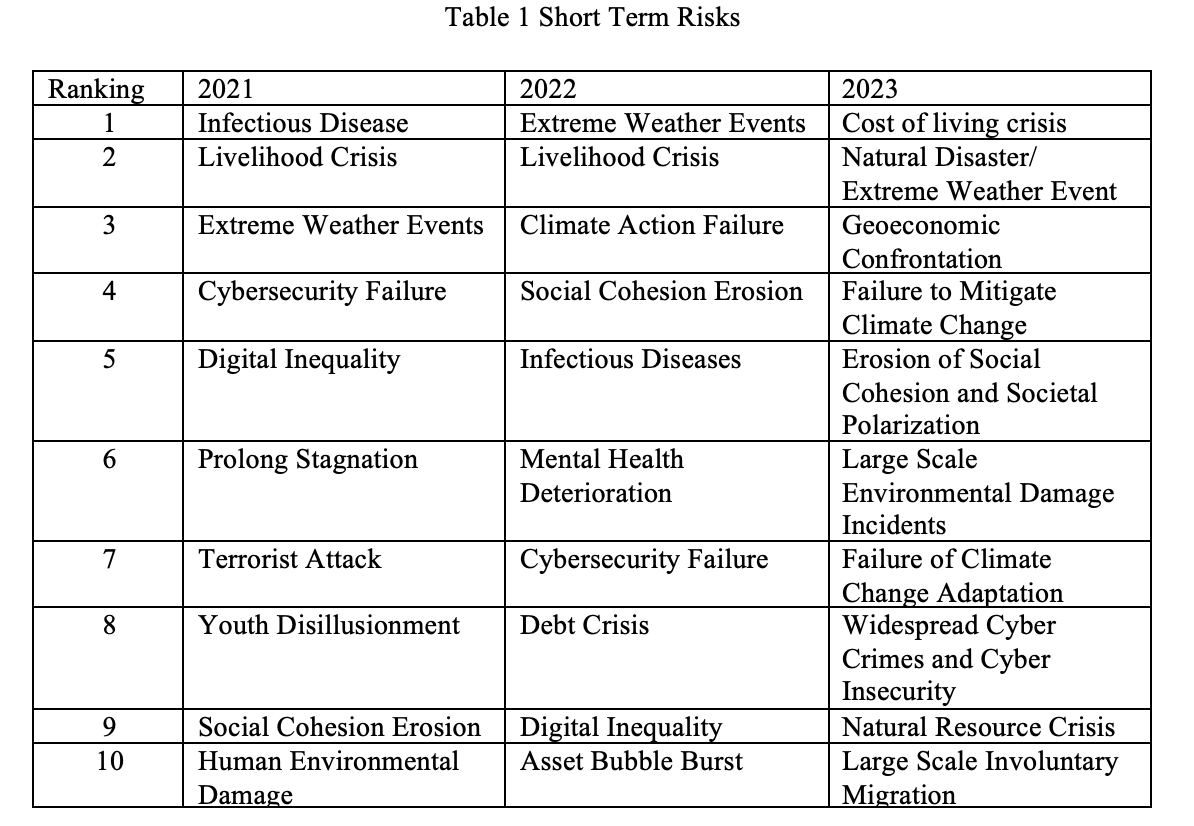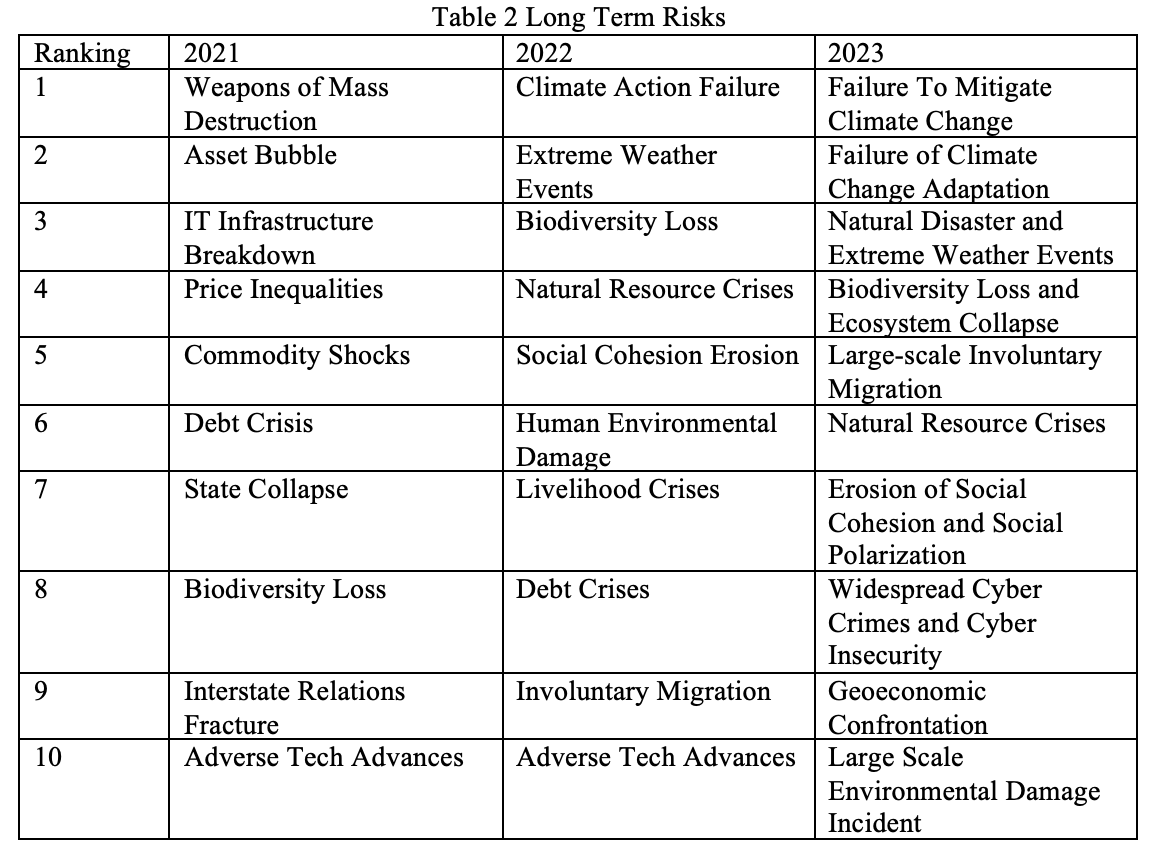 Every year for over twenty years, the World Economic Forum has conducted a Global Risks Perception Survey. The 2023 survey was conducted between September 7 and October 5, 2022. The responses are from over 12,000 business leaders in 21 countries.
Every year for over twenty years, the World Economic Forum has conducted a Global Risks Perception Survey. The 2023 survey was conducted between September 7 and October 5, 2022. The responses are from over 12,000 business leaders in 21 countries.
In the survey, Global Risk is defined as “the possibility of the occurrence of an event or conditions which, if it occurs, would negatively impact a significant portion of global GDP, population, or natural resources.” (1)
The respondents were asked to look at the issue of risk on several levels.
1..Volitility
2. Severity – likely impact over a one-, two-, and ten-year horizon.
3. Consequence – potential impact.
4. Risk preparedness and governance – current effectiveness of ability to manage risk.
5. Qualitative Knowledge – identifying new or emerging risks.
Risks
In 2022 there were 32 global risks listed. The 2023 survey added two risks associated with economic geopolitical and environmental trends. These were a: Cost of Living crisis and b: Misinformation and disinformation. A slight change was made on a climate risk. The risk “Climate action failure” was separated into a: Failure of climate-change adaptation” and b: Failure to mitigate climate change.
The identified risks from the responses are grouped into two basic categories. These are short term and long term. Short-term risks are generally those which might occur within the next two years. Long-term risks are those likely to occur within the next ten years.
Tables 1 and 2 below show the short-term and long-term risks for 2023, 2022 and 2021. It should be noted that in 2022 and 2021 risks were identified as 2 years, 2-5 years, and 5-10 years. Thus, to make the comparison with 2023, the 2021, and 2022, the 2-5 years, and 5-10 years risks have been combined and ranked based on the percentages regardless of anticipated incident of occurrence.
Assessment
If one compares the 2021 and 2022 short-term risks, four out of ten risks appear in both years. These are Livelihood Crisis, Extreme Weather Events, Cybersecurity Failure and Digital Inequality. Of these only two, Widespread Cyber Crimes and Cyber Insecurity, and Natural Disaster/ Extreme Weather Event appear in the top ten short-term 2023 risks. Comparing the 2022 and 2023 top ten short-term risks indicates that four Natural Disaster/ Extreme Weather Event, Failure to Regulate Climate Change, Widespread Cyber Crimes and Cyber Insecurity are carried over.
The point is that except for climate change and cybersecurity, the short-terms risks jump around from year to year. This makes it difficult to determine whether the exclusion of an individual risk from the top ten is the result of mitigative actions or more of the popular perception of the times. For instance, in 2020 only two of the top ten short-term risks were climate related. By 2023 half were climate related.
With respect to the long-term risks the same trend is apparent. In 2020 only one was climate related. That was Biodiversity Loss. By 2023 six were climate related risks.
This trend towards an emphasis on climate related risks is something I noted in a 2019 CERM article. (2) In fact, except for cyber security, there is no risk in the top ten which can be linked to an organization or which an organization can reasonably mitigate. The emphasis is on state actors and government action.
The Executive Summary points out the complexity of the situation state actors face.
“As 2023 begins, the world is facing a set of risks that feel both wholly new and eerily familiar. We have seen a return of “older” risk -inflation, cost-of-living crises, trade wars, capital outflows from emerging markets, widespread social unrest, geopolitical confrontation and the specter of nuclear warfare -which of nuclear warfare – which few of this generation’s business leaders and public policy-maker have experienced. These are being amplified by comparatively new developments in the global risk landscape, including unstainable levels of debt, a new era of low growth, low global investment and de-globalization, a decline in human development after decades of progress, rapid and unconstrained development of dual-use (civilian and military) technologies, and growing pressure of climate change impact and ambitions in an ever-shrinking window for transition to a 1.5°C world.” (3)
How the emphasis on climate related risks compared to the other risks plays out politically has yet to be determined. What is clear, the World Economic Forum is emphasizing climate risk.
Endnotes
- The Global Risk Report 2023, World Economic Forum, page 5, hppts://www.weforum.org/report/global-risks-report-2023.
- Kline, James J., 2019, World Economic Forum Risk Assessment Survey, CERM Insights #240, May 10, 2019.
- The Global Risk Report 2023, The Global Risk Report 2023, page 6, hppts://www.weforum.org/report/global-risks-report-2023.
BIO:
James J. Kline has a PhD from Portland State University. He has worked for the federal, state, and local government. He has consulted on economic, quality and workforce development issues. He has authored numerous articles on quality and risk management. His book “Enterprise Risk Management in Government: Implementing ISO 31000:2018” is available on Amazon. He edited “Quality Disrupted” which is also available on Amazon. He can be contacted on LinkedIn or jamesjk1236@outlook.com

